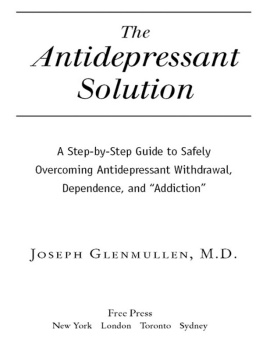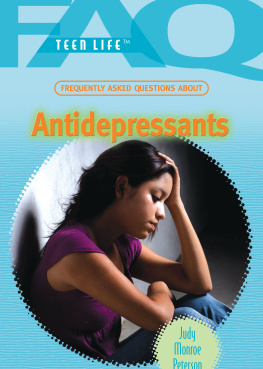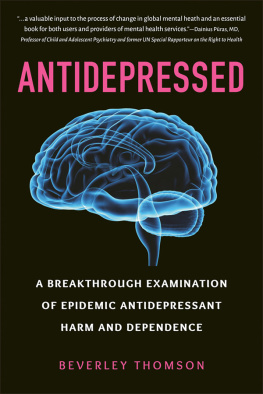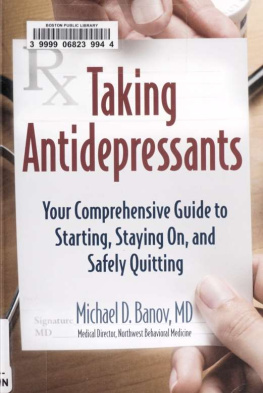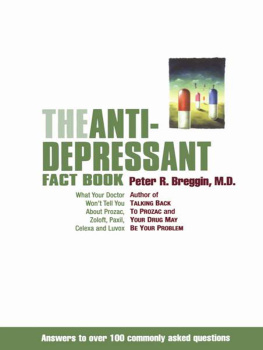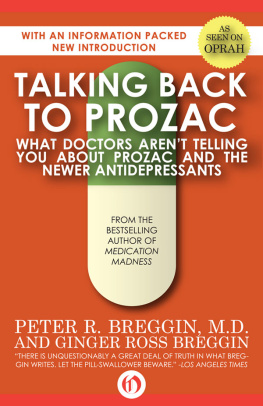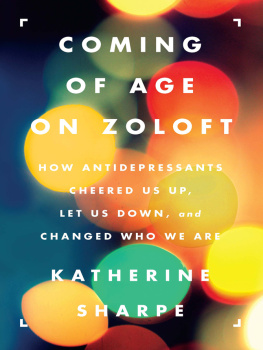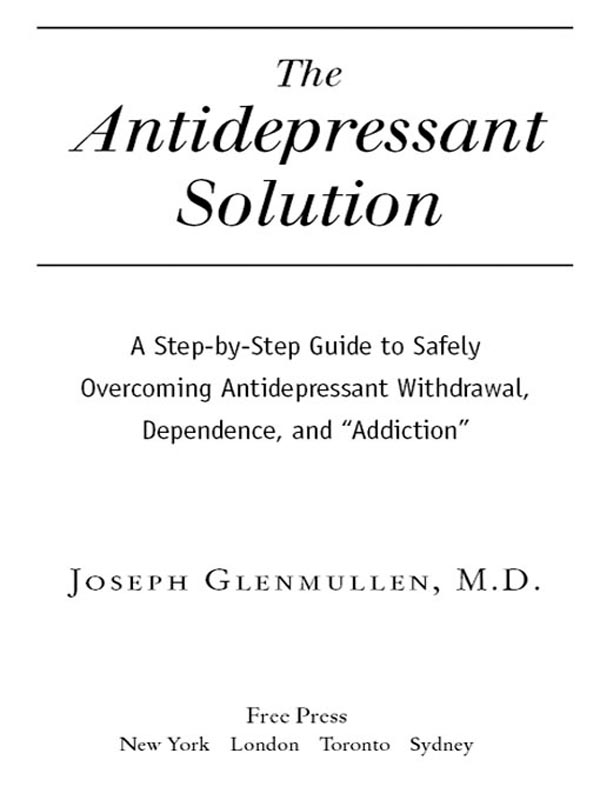Also by Joseph Glenmullen, M.D.
Prozac Backlash
Sexual Mysteries
To Ciara, Peter, and Michael
This publication contains the opinions and ideas of its author. It is intended to provide helpful and informative material on the subjects addressed in the publication. It is sold with the understanding that the author and publisher are not engaged in rendering medical, health, or any other kind of personal professional services in the book. The reader should consult his or her medical, health, or other competent professional before adopting any of the suggestions in this book or drawing inferences from it.
The author and publisher specifically disclaim all responsibility for any liability, loss, or risk, personal or otherwise, which is incurred as a consequence, directly or indirectly, of the use and application of any of the contents of this book.
While the case studies described in this book are based on interviews with real persons, including patients treated by the author, the names, professions, locations, and other biographical details about the participants have been changed.
FREE PRESS
A Division of Simon & Schuster, Inc.
1230 Avenue of the Americas
New York, NY 10020
Copyright 2005 by Joseph Glenmullen
All rights reserved, including the right of reproduction in whole or in part in any form.
F REE P RESS and colophon are trademarks of Simon & Schuster, Inc.
Designed by Paul Dippolito
The Library of Congress has catalogued the hardcover edition as follows:
Glenmullen, Joseph.
The antidepressant solution: a step-by-step guide to safely overcoming antidepressant withdrawal, dependence, and addiction / Joseph Glenmullen.
p. cm.
Includes bibliographical references.
1. Antidepressants. I. Title.
RM332.G56 2005
616.85'27061dc22 2004063202
ISBN-10: 0-7432-8898-X
ISBN-13:978-0-7432-8898-9
Visit us on the World Wide Web:
http://www.SimonandSchuster.com
Preface
As I wrote this book in 2004, doctors and the public experienced an up-heaval in their view of the safety of todays popular antidepressants because the Food and Drug Administration issued a pair of warnings that have been startling to many: Antidepressants may make patients suicidal. In the initial March 2004 warning, the FDA asserted that adult and pediatric patients on antidepressants can develop a range of side effects that may make them suicidal, including anxiety, agitation, panic attacks, insomnia, irritability, hostility, impulsivity, akathisia (severe restlessness), hypomania, and mania.
The FDA warning is truly historic; it is the first time the agency has acknowledged that antidepressant drugs can make some patients suicidal. Until 2004, the FDA and pharmaceutical industry insisted that suicidality was more likely to be due to a patients underlying psychiatric condition. Now the FDA has said unequivocally that antidepressant-induced suicidality is beyond the suicidality as a result of the disease. Indeed, the warnings apply to all thirty-two antidepressants currently on the market, including all of the older tricyclic and monoamine oxidase inhibitor antidepressants. The complete list of antidepressants can be found in Table P.1. In light of the FDA warnings, patients and their doctors should not change the dose of antidepressants up or down without being well informed about how to do so safely and comfortably.
The FDA is following the lead taken by its British counterpart, the Medicines and Healthcare products Regulatory Agency, the MHRA. In 2003, the British issued a series of warnings and virtually banned many antidepressants for children and adolescents under the age of eighteen. The British advised against the drugs because of the evidence in pharmaceutical company studies that the antidepressants are no more effective in children than placebo (dummy) pills but can make children agitated, sleepless, hostile, aggressive, and suicidal. While the British MHRA has virtually banned many antidepressants for some age groups, the FDA warnings have not banned any of the drugs.
The American and British warnings have been accompanied by allegations that the pharmaceutical industry suppressed data on these lethal side effects for years. According to an article in the March 2004 issue of the Canadian Medical Association Journal, GlaxoSmithKline tested its drug Paxil on children and adolescents from 1993 to 1996. How did the report propose to effectively manage the potentially damaging results? By selectively publishing the few positive data that would appear to make Paxil look good.
Table P.1. ANTIDEPRESSANTS COVERED BY THE FDAS WARNINGS THAT THE DRUGS MAY MAKE PATIENTS SUICIDAL
(Brand names are capitalized; generic names are in parentheses.)
- Anafranil (clomipramine)
- Aventyl (nortriptyline)
- Celexa (citalopram)
- Cymbalta (duloxtine)
- Desyrel (trazodone)
- Effexor (venlafaxine)
- Elavil (amitriptyline)
- Lexapro (escitalopram)
- Limbitrol (amitriptyline/chlordiazepoxide)
- Ludiomil (maprotiline)
- Luvox (fluvoxamine)
- Marplan (isocarboxazid)
- Nardil (phenelzine)
- Norpramin (desipramine)
- Pamelor (nortriptyline)
- Parnate (tranylcypromine)
- Paxil (paroxetine)
- Pexeva (paroxetine mesylate)
- Prozac (fluoxetine)
- Remeron (mirtazapine)
- Sarafem (fluoxetine)
- Serzone (nefazodone)
- Sinequan (doxepin)
- Surmontil (trimipramine)
- Symbyax (fluoxetine/olanzapine)
- Tofranil (imipramine)
- Tofranil PM (imipramine)
- Triavil (amitriptyline/perphenazine)
- Vivactil (protriptyline)
- Wellbutrin (bupropion)
- Zoloft (sertraline)
- Zyban (bupropion)
To accomplish this goal, GlaxoSmithKline turned to the psychiatrists who conducted the studies for the company. Headed by Dr. Martin Keller, chairman of the Department of Psychiatry and Human Behavior at the Brown University School of Medicine, a group of more than twenty leading academic psychiatrists published the selected Paxil data in the July 2001 issue of the Journal of the American Academy of Child and Adolescent Psychiatry.
After the British and FDA warnings, in April 2004 the prestigious medical journal The Lancet published a damning critique of Kellers and a number of other similar antidepressant studies.
Kellers misleading 2001 report in the Journal of the American Academy of Child and Adolescent Psychiatry was highly influential and widely used to promote prescribing antidepressants to children. Since then the use of the drugs for children has skyrocketed.
In many instances, pharmaceutical companies ghostwrite the favorable drug studies published in academic journals. This practice, too, is increasingly coming under fire.
The FDA has been heavily criticized for its handling of antidepressant-induced suicidality.
What do doctors and patients do when patients are ready to go off the drugs if stopping antidepressants abruptly can cause severe withdrawal reactions that include suicidality, impulsivity, aggression, dizziness, vertigo, nausea, vomiting, headaches, tremors, electric zap sensations in the brain, anxiety, crying spells, and insomnia? The problem is compounded by the fact that nowadays 70 percent of prescriptions for antidepressants are written by family doctors, many of whom do not know how to taper patients off the drugs. With so many people using the drugs, withdrawal and dependence have become major problems.

